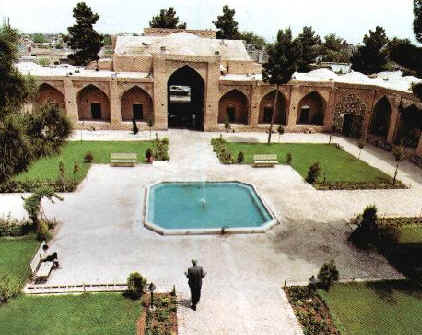|
|
Address: Khayam Sq., Neishabour, Iran
Complex Phone: +98-551-22039
Museum Phone: +98-551-40907
Caravanserais in Iran are very ancient. According to the historical resources, Achamenid dynasty established the first foundations of caravansary is in Iran. In Sassanid era, and then, because of the development of connective roads as well as ever-increasing economical activities, in addition to military factors, they were considerably increased in numbers. Their qualities in construction also were developed. The highest point of their evolution could be considered in period of Safavid dynasty.
This caravansary was built outside the city gate (Meshed Gate) in Safavid period. The structure is four-porch building in square form, with dimensions of 68x69 meters. Building has a central yard surrounded by 24 chambers. Entrance is via Northern portico, which has a multi-lateral narthex. Behind the chambers, there are stables, which were used in that time to keep horses and domestic animals. There were also platforms where passengers used to put their luggage and properties. Materials applied in caravansary building are bricks filled with plaster and sand mixture as well as stone applied in foundation.
This caravansary was used as a place to dwell and keep orphans and poor people in the late Qajar and early Pahlavi eras. Then it was used as a garrison for gendarmerie troops for a while. It was until 1995 when, synchronized with holding International Congress of Attar, it was reconstructed as a cultural center.
The main purpose to revive caravansary, was to support handicrafts and maintain traditional and native art. At the present time, Eastern side of the caravansary is devoted to Neishabour region, which is a kind of regional and native museum.
In new application of caravansary, all chambers and narthexes around the central yard, are used as workshops to produce handicrafts such as Giveh (light cotton summer shoes), wickerwork, weaving carpet, making sieves, xylographic and grating on wood, tile painting, pottery, filleting miniatures, making traditionally fashion clothes, grinding turquoise, selling publications, making traditional music instruments, traditional photography shop, pottery repair workshop, designing and sample-making of archaic pottery, and etching.
The western side is also used as an amphitheatre, a permanent exhibition for traditional artistic works, and training workshops. In southeast narthex, a high school has been established to train students the skills of pottery, tiling and ceramics in the field of labor-knowledge (cultural heritage) with cooperation of Ministry of Education. Students receive diploma certificate in arts after the termination of their secondary school course.
Some other caravansaries are located on the Silk-Road, near Neishabour as well. The most important of them are Shouriab Carvansary, situated 50 km South-west of Neishabour, in Shouriab village. Dating back to Qajar period, it is one of the most handsome and resplendent caravansaries. Other caravansaries are Chahsalar, South of the city, Qadamgah and Vazir Castle, on the road to Meshed. Each of them enjoys special important.

|
|

